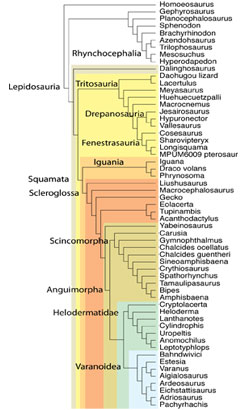Will you look at the feet on that thing!!

Figure 1. Dalinghosaurus, a beautiful and complete specimen. IVPP V13281, Barremian, Hejiaxin, China. 2cm skull length
Dalinghosaurus longidigitus (Ji 1998) Early Cretaceous was reported (Evans and Wang 2005) to be related to the modern-day lizards in the family Xenosauridae (Shinisaurus in China), Xenosaurus in Mexico and two extinct lizards, Exostinus and Carusia. Unfortunately they didn’t expand their inclusion set (see below). One fossil skeleton of Dalinghosaurus included ten juveniles. Despite the disparity in limb length, Evans and Wang (2005) considered Dalinghosaurus a climber, not a biped.
A Key Taxon at the Base of the Squamata + Tritosauria
In the large study Dalinghosaurus nested outside the Squamata (Iguania + Scleroglossa) and the Tritosauria, as a sister to Homoeosaurus and Gephyrosaurus on the primitive side and Lacertulus + the Daohugou lizard and Iguana on the more derived side. Shinisaurus, Exostinus and Xenosaurus were not included in the large study, but it is doubtful that they were closer sisters because Carusia and a sister to Shinisaurus, Bahndwivici, nested at the base of the Anguimorpha, well within the Scleroglossa.
Until a better candidate comes along a sister to Dalinghosaurus was THE basal squamate + tritosaur from which all other squamates evolved. A new clade is needed to include the Squamata, the Tritosauria and Dalinghosaurus. The Dalinghosauria is defined as Dalinghosaurus, Iguana, their last common ancestor and all of its descendants.
The Homoeosaurus Connection
Distinct from Homoeosaurus, the skull of Dalinghosaurus had a larger orbit and a deeper preorbital bone with a reduced lacrimal. The jugal and postorbital bones were relatively more gracile. The mandible was deeper with a longer, deeper retroarticular process.
The cervicals were longer. The dorsal ribs were much wider producing a flattened cross-section. The transverse processes of the anterior caudals were longer. The tail was longer and more robust.
The scapulocoracoid was fused and fenestrated anteriorly. The interclavicle is cruciform. The humerus, radius and ulna were more gracile. The metacarpals were longer.
The pubis was longer and the ischium was more robust. The feet were much longer and longer than the femur + tibia. The astragalus and calcaneum were co-ossified.
Adding Taxa to the Large Study
Along with Dalinghosaurus, I recently added several taxa to the Lepidosauria. Each one found a nesting site without rearranging any other portion of the tree. This is a sign of tree strength.
References
Evans SE and Wang Y 2005. The Early Cretaceous lizard Dalinghosaurus from China. Acta Palaeontologica Polonica 50 (4): 725–742. online pdf
Ji SA 1998. A new long−tailed lizard from the Upper Jurassic of Liaoning, China. In: Department of Geology, Peking University (ed.), Collected Works of International Symposium on Geological Science, Peking University, Beijing, China, pp 496–505. Seismological Press, Beijing.



